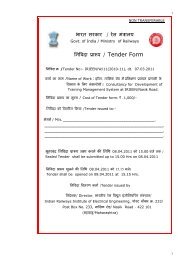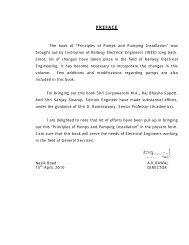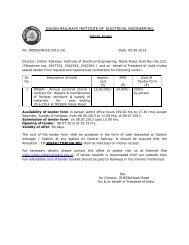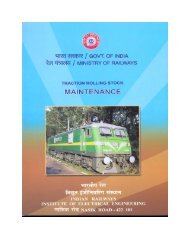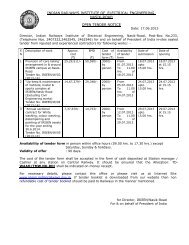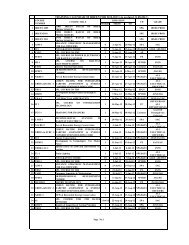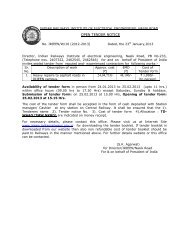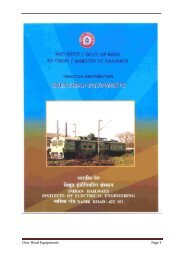remote control equipment - Indian Railways Institute of Electrical ...
remote control equipment - Indian Railways Institute of Electrical ...
remote control equipment - Indian Railways Institute of Electrical ...
Create successful ePaper yourself
Turn your PDF publications into a flip-book with our unique Google optimized e-Paper software.
3.6.2. Oil Level in Transformers, Circuit Breakers, CTs etc.<br />
Check oil level in sight gauge glass and examine all joints, valves, plugs etc.<br />
for oil leakage in each <strong>equipment</strong> rectify leaky parts if found and restore the oil level.<br />
3.6.3. Insulators<br />
Clean all insulators with dry cloth and look for any flashover marks, cracks,<br />
chippings. Insulators which are badly chipped should be replaced. Minor chippings<br />
can be rendered impervious to moisture by a light coating <strong>of</strong> Araldite or similar epoxy<br />
resin.<br />
3.6.4 Traction Transformers<br />
1. Clean externally the tank, conservator, radiator, bushings, oil level<br />
indicator, gauges, etc. with dry cloth.<br />
2. Make a note in the Register <strong>of</strong> the maximum temperature <strong>of</strong><br />
transformer oil on dial indictor, reset indictor.<br />
3. Check explosion vent diaphragm for any damage and presence <strong>of</strong> oil.<br />
4. Check silica-gel breather. If turning pink in appearance, replace it with<br />
dry gel (blue colour) and recondition the old silica-gel. If the silica-gel<br />
is too wet, check di-electric strength <strong>of</strong> transformer oil.<br />
5. Check for gas collection, if any. In Buchholz relay<br />
6. Check for oil leakage on transformer body, conservator tank, oil drain<br />
valve and foundations. If leaking, take corrective action by tightening<br />
the bolts, replace gaskets, if necessary.<br />
7. Check if heater in the marshalling box is functioning properly, and if all<br />
terminal connections are in order.<br />
3.6.5. Operating Mechanism <strong>of</strong> Circuit Breakers and Interrupters<br />
1. Open the cover <strong>of</strong> <strong>control</strong> box Examine the interior ad remove the<br />
accumulated dust. If any part <strong>of</strong> the interior Is badly rusted indicating<br />
entry <strong>of</strong> moisture, find out the cause, plug the holes and repaint the<br />
rusted part. Check in particular if the weather-pro<strong>of</strong> gaskets are in good<br />
condition; if not. replace them to make the contain box water-tight and<br />
dust-tight. Examine if the leading in pipe connections are properly<br />
bushed, sealed and waler tight. Check if all pins and checkouts are in<br />
place. Check also tie-rod nuts for tightness.<br />
2. Operate the mechanism at least twice manually. Have it operated on<br />
<strong>remote</strong> <strong>control</strong> from RCC; keeping the <strong>control</strong> door open, observe<br />
whether the mechanism functions smoothly without any rubbing or<br />
37




